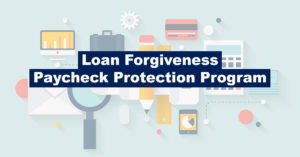Updated Tuesday, August 18, 2020.
By Tommy Greer
The PPP Loan Forgiveness Application that will be submitted to the lender is finally out and can be found at this link. We have also updated our Loan Forgiveness Calculation Workbook.
This application has four parts with only 1 and 2 required to be submitted to the lender:
- the PPP Loan Forgiveness Calculation Form;
- PPP Schedule A;
- the PPP Schedule A Worksheet; and
- the (optional) PPP Borrower Demographic Information Form.
The Application also includes a page of certifications to sign and four and a half pages of instructions providing some clarity, but some of our questions still remain. Below are some highlights.
PAYROLL COSTS INCURRED AND/OR PAID
- The borrower with a bi-weekly (or more frequent) payroll cycle may elect to use for payroll costs only, an alternative 8-week period, that more aligns with their payroll schedule – Alternative Payroll Covered Period (APCP). This period begins on the first day of the first payroll cycle after loans funds are disbursed.
- Payroll costs paid or incurred during covered period or APCP are clearly eligible for forgiveness
- Payroll costs incurred during the last pay period are included if paid on or before the next regular payroll date even if that is beyond the 8-week period
- Payroll costs can include pay to employees who are not working
- Payroll costs can also include payments to furloughed employees; bonuses; or hazard pay
- Total amount of cash compensation eligible for forgiveness for any individual employee cannot exceed $15,385
- Owner-employees (corporations) cash compensation includes employer retirement and health care payments made on their behalf capped at the lesser of $15,385 or 2019 cash compensation and
- No additional forgiveness is provided for retirement or health insurance contributions for self-employed individuals, including Schedule C filers and general partners, as such expenses are paid out of their net self-employment income.
NONPAYROLL COSTS
Eligible nonpayroll cost must be paid or incurred during the Covered Period and paid on or before the next regular billing date, even if the billing date is after the Covered Period.
FTE CALCULATION CLARIFIED
SBA has clarified that a full-time equivalency (FTE) employee will be calculated based on a 40-hour workweek.
Borrowers are allowed a simplified calculation method option if they choose, to assign 1.0 to employees who work 40 hours or more and 0.5 to employees who work fewer than 40 hours.
FTE reduction exceptions exist for situations in which an employee declines a borrower’s good-faith, written offer to rehire, and for employees (a) that voluntarily quit, (b) were fired for cause, or (c) voluntarily requested a reduction in hours.
If the employee declined the borrower’s offer the rehire, the borrower is to inform the applicable state unemployment insurance office of such employee’s rejected offer of reemployment within 30 days of the employee’s rejection of the offer.
WAGE REDUCTION RULE
For the wage reduction calculation, the SBA has clarified that borrowers should compare the average annualized wages (not the total paid wages) or hourly rate of the relevant employee in the first quarter of 2020 against those paid in the covered payroll period or alternative covered payroll period.
Any employee that made more than $100,000 on an annualized basis during “any single pay period” in 2019 is excluded from this calculation.
CERTIFICATIONS AND DOCUMENTATION
There is a full page of certifications and documentation requiring the borrower to certify, among other things, that (a) funds were used to pay costs that eligible for forgiveness, (b) the loan was used for authorized purposes, and (c) the information and supporting documents are true and complete in all material respects.
Borrowers will be required to maintain documentation, including documentation supporting the necessity of their loan request and eligibility for six years after the loan is forgiven or repaid in full.
PAYCHECK PROTECTION PROGRAM FLEXIBILITY ACT
The House is currently working on a bill to make the following changes (and may have already passed as you read this):
- allow forgiveness for expenses beyond the 8-week covered period (possibly 10-24 weeks);
- eliminate restrictions limiting non-payroll expenses to 25 percent of loan proceeds;
- eliminate restrictions that limit loan terms to two years;
- ensure full access to payroll tax deferment for businesses that take PPP loans; and
- extend the rehiring deadline to offset the effect of enhanced Unemployment Insurance.
The Trump administration supports the 8-week period also. No current word on overruling IRS’s stance that expenses paid with PPP funds are nondeductible. None of this is final so who knows what the final bill will look in the end so stay tuned!
In conclusion, it does seem everyone, except the IRS, is working together to try to make the PPP more borrower friendly, more to come…

